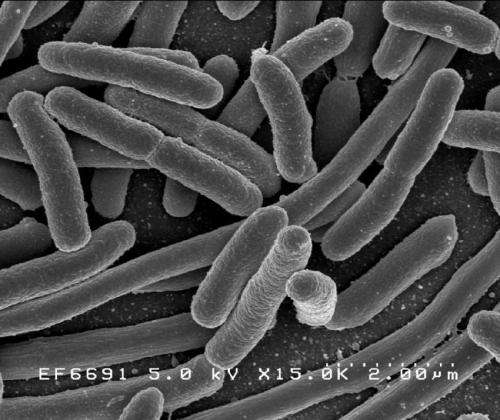Engineers devise new method to remove harmful E. coli from water
Published on by Water Network Research, Official research team of The Water Network in Academic

Escherichia coli. Credit: Rocky Mountain Laboratories, NIAID, NIH
Engineers at Monash University have come up with an improved method to remove potentially deadly bacteria, such as E. coli, from water using graphitic carbon nitride and sunlight.
The international team, led by Professor Xiwang Zhang in Monash University's Department of Chemical Engineering, combined graphitic carbon nitride with polyethylenimine (PEI) to destroy harmful pathogens E. coli and Enterococcus faecalis from water within 45 minutes and 60 minutes respectively.
This new photocatalyst method is low cost and metal-free, which prevents secondary pollution of leached metal ions during the filtration process.
If upscaled, this solar-driven method could significantly improve the treatment of large volumes of water. It also has the potential to be integrated into current solar water disinfection technology in countries with limited access to fresh water.
Published in the journal Applied Catalysis B: Environmental , Professor Zhang says integrating their photocatalyst into solar water disinfection technology could nearly ensure complete and rapid disinfection in a more sustainable way.
"Infectious diseases caused by waterborne pathogens threaten the health of people worldwide," said Professor Zhang, who is also the Director of the ARC Research Hub for Energy-efficient Separation.
"Graphitic carbon nitride has gained broad attention as a metal-free photocatalyst for water disinfection. However, it has limits in its capacity to remove pathogens completely using photocatalysis. What we've been able to do is fuse graphitic carbon nitride with PEI to boost photocatalytic properties of this material and test it on waterborne bacteria. We discovered the PEI functionalisation can, in effect, tune the photochemical reactions on graphitic carbon nitride. We found that the positively charged PEI on graphitic carbon nitride could promote the contact between photocatalyst and bacteria cells (negatively charged surface) via electrostatic adhesion, which can enable reactive oxygen species to kill the trapped bacteria cells."
A previous study published by the research team in ACS Catalysis found PEI on graphitic carbon nitride provided a trap site for photoinduced holes. Through this, PEI can tune the photochemical reactions to generate more reactive oxygen species for bacteria inactivation.
Through this process, PEI changes the surface charge of the composite photocatalyst to be positive; in nature, the surface of bacteria cells is negatively charged due to the specific moieties of their cell structure.
Taxonomy
- Bacteria
- E. coli
- waste water bacteria